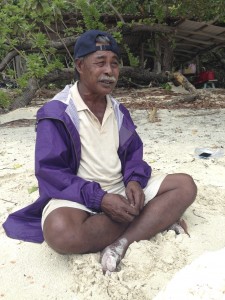We have just returned to Koror from our two-day trip in Ollei, a small village located in the northern end of Ngarchelong state of Palau. We spent most of the visit with local women and fishermen who generously shared their knowledge with us regarding fish spawning cycles, lunar and tidal patterns, and the community’s clam, sea cucumber and inshore fisheries. During our trip, we learned about Ollei’s traditional conservation institutions, and how the community’s traditional ecological knowledge and management helped to build the foundation for the Ebill Conservation Area established in 2000.
We were lucky enough to start our second day with a snorkel in the Ebill Conservation Area. We walked down to the small harbor, loaded ourselves into two boats and sped off towards the reef with a few knowledgeable fishermen to lead the way. A short while later, we anchored in Ebill Channel, threw on our masks and snorkels, and kicked our way over to the reef. The species diversity and richness were a snorkeler’s dream –everywhere you looked there were colorful fish darting in and out of the reef, beautiful corals, iridescent clams, and larger fish like grouper and jacks hiding under the overhangs near the drop-off.
After our snorkel, we headed to a nearby beach to learn about sea turtle nesting behavior from Joshua Eberdong, a local sea turtle expert. We sat in the sand as he told us the Palauan legend that explains the relationship between two IUCN red-listed species found on the island – the hawksbill sea turtle and the megapode, a large chicken-like bird.

The legend goes that a woman who lived in a small village near Ollei gave birth to a hawksbill sea turtle and a megapode. Every day, while the woman was away from the house tending to her taro patch duties, the turtle would dig holes and the bird would dig large mounds in the yard and every day, the woman would return from a hard day’s work to find a giant mess awaiting her. One day, the turtle and megapode overheard their mother complaining about all the extra work they caused her, and so decided to find their own place in the world. Early the next morning they went down to the beach and as they sat there, the megapode wondered how they would travel out to the sea. The turtle said to his sibling ‘don’t worry, hop on my back and I will do the swimming.’ So they traveled south where they found an island where the megapode decided to settle down. The turtle said he would continue further south to the Rock Islands. Before they parted ways, the megapode said to the turtle ‘make sure that when it is time for you to have your children, put them up on the sand where they have a greater chance of surviving and I will be able to assist them’. And to this day, that is the behavior of the megapode – it makes its nest in the sand close to Hawksbill nests, where it brings leaves down to the shore for turtle hatchlings to take cover under. Thus wherever there are Hawksbill turtle nests, you can find a megapode nest nearby.

I thought the legend of the turtle and the megapode was a particularly poignant example of what we had come to Ollei to learn about – traditional ecological knowledge and conservation, and the role those play in modern-day local conservation. Anne Singeo, one of the founders of the Ebill Society, explained to us that “people learn better when there is a story attached to the knowledge,” and that through these traditional legends and stories, valuable ecological knowledge is maintained through generations.
She ends on an optimistic note: “Hopefully with these stories, we can have better and more creative conservation policies that address species that support one another in their own habitats.”
While the Ebill Conservation Area is part of Palau’s official Protected Area Network, Ollei also still relies on traditional management and conservation tools. Our day in Ollei illustrated how much traditional ecological knowledge one small community possesses, and how that knowledge can be used to help inform and design the management policies of today.
